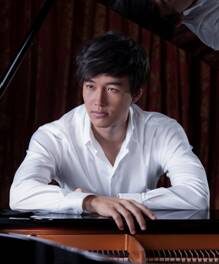Duke Symphony Orchestra, under the baton of Harry Davidson, presented a creative program of stark contrasts. Well attended for a weekday night, the concert featured guest artists on flute and harp performing some rarely heard pieces sandwiched between two frequent-flyer Beethoven favorites.
Harry Davidson’s approach to Beethoven emphasizes melodrama and passion. If you like your Beethoven bombastic, this is the guy to go see. Both the Overture to The Creatures of Prometheus, Op. 43 and Symphony No. 7 in A, Op. 92 featured the full complement of violins (40+ players in the combined violin sections), which presented some balance problems with the meager six violas. The overture was, nonetheless, exciting and a rousing opening number.
The middle section of the concert featured two soloists with ties to the Cleveland Institute of Music. Madeline Lucas Tolliver, flute, and Laura Smithburg Byrne, harp, both collaborated on works that showcased their respective instruments. Tolliver’s interpretation of W.A. Mozart’s Andante in C for Flute and Orchestra, K. 315 was tasteful, graceful, and passionate without being overly romanticized. This work has perhaps more merit than the more frequently performed flute concerto by the same composer; it’s charmingly constructed and benefits from not being originally written for oboe. Tolliver was joined by Byrne for the colorful and atmospheric Serenade for Flute, Harp, and Strings, Op. 35 by Howard Hanson. The wholly modern sound was a refreshing contrast from the rest of the program, and showcased the versatility of the ensemble.
Both soloists returned again for Mozart’s Concerto in C for Flute, Harp, and Orchestra, K. 299. Unfortunately the heat in the hall and the humidity outside negatively influenced the tuning of Byrne’s instrument. Nevertheless, but both she and Tolliver performed with rich musicality and sensitivity. Even so, the composition itself paled in comparison to the Beethoven warhorses on the program. Mozart is not remembered for treating either the flute or the harp kindly in his letters, and his distaste really does seem to carry over into his compositional style. The comparatively insipid work was eclipsed by the glorious seventh symphony by Beethoven. That said, the cadenza in Mozart’s last movement has some really lovely moments that were beautifully highlighted by both soloists.
The orchestra size was cut down considerably for the Mozart and Hanson works, with half of the number of violins playing. Having fewer players did wonders for the balance issues that plagued both of the “bookend” works. Additionally, the more subtle gestures that Davidson called for were realized much more effectively. When the crowd of violins (and assorted brass and percussion) returned to the stage for Beethoven’s seventh symphony, Davidson’s dramatic side returned. While the outer movements seemed a little overdrawn, the brilliant thematic exploration of the second movement fared very well under this treatment.
Duke Symphony Orchestra has some snazzy programs planned for the spring semester, and their prices literally can’t be beat. See our calendar for details.











